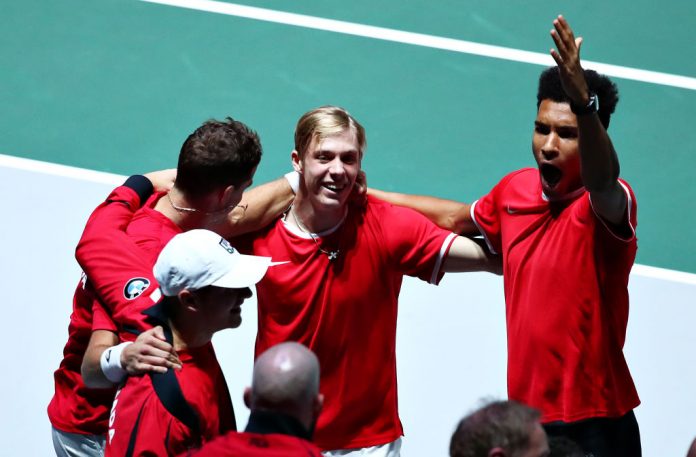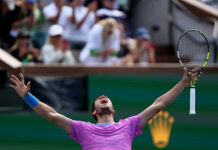Bill Simons
Madrid
The baseball cap I spotted on my first day at the Davis Cup made a bold boast: “The North Over Everybody.”
I bristled. “C’mon,” I thought. “Isn’t my country, with its ‘USA! USA!’ chants and American exceptionalism, supposed to be No. 1 when it comes to North American bragging rights?
Think again. After Canadian Bianca Andreescu won titles in Indian Wells and Toronto, she seemed to leave Ms. Serena wondering what hit her at the US Open. The Golden State Warriors were supposed to sweep by the Toronto Raptors, but Stef Curry and company haven’t recovered. Now Canada’s men have capped off a break-out year with a stunning run to their first ever Davis Cup final.
They were without two of their three best players. Milos Raonic didn’t make the trip and the incredibly appealing teen, No. 21 Felix Auger-Aliassime was, due to an injury, reduced to being a charismatic cheerleader.
No worries. “Thank goodness Denis [Shapovalov] has ice in his veins,” said Vasek Posipisil. Today after the Canadians split the first two singles matches with Russia, déjà vu set in. Just like yesterday, the young, powerful duo of Karen Khachanov, No. 17, and Andrey Rublev, No. 23, were living on the edge. They again went deep into a tense third-set tiebreak.
Just 24 hours ago they’d somehow survived the brilliance of Novak Djokovic, and rebuffed three match points to emerge in an epic du jour match. They prevailed in a third-set tiebreak, 10-8.
Again, today the Russians came out swinging. They took the lead in the tie-break, thanks to a blistering Khachanov return of serve. If Djokovic, the player of the decade, and his wily partner, the 33-year old Viktor Troicki, couldn’t subdue the imposing Russians, how could Shapovalov, a 20-year-old ranked No. 14 and his partner, the former Wimbledon doubles champion Pospisil, ranked No. 168, do it?
But amazingly, the Canadians saved five break points in Shapovalov’s last two service games and Pospisil tapped his inner Federer in the tiebreak as he lifted his game brilliantly, a timely upgrade that enabled him and the gutsy Shapovalov to prevail 6-4, 4-6, 7-5 (5).
Tennis, like a thing or two else in life, is so much about execution under pressure. Serb player Troicki famously said yesterday, “God gave me once [a chance] to be the hero, maybe to win the Davis Cup in the deciding rubber. Now he took it away.”
It’s likely that God doesn’t waver under pressure, but the Serbs did, while the Canadians swung freely. Shapovalov explained, “Not only do we play well together, we’re able to enjoy the moment…We’re having fun, and regardless, win or lose, we were both are enjoying it…It’s just a dream come true. It’s ridiculous.”
Well, not really. It is true that Canada’s population is just lightly more than one tenth that of the US. It is ranked just No. 14 in the Davis Cup rankings, and tomorrow will be their first Davis Cup final ever. Still, Canada has had a spectacular tennis year.
Why the success? About a dozen years ago, they brought in French developmental whiz Luis Borfiga, who transformed everything: a tennis center in Montreal and hefty financial investments. The “bump theory” claims the emergence of former No. 3 Milos Raonic, Genie Bouchard and Pospisil. Then there is the openness of Canada. Before they came to Canada, Pospisil’s parents escaped Soviet Czechoslovakia. The families of Raonic, Shapovalov and Andreescu came from Montenegro, Russia and Romania respectively. Auger-Aliassime’s dad is from Togo.
Then again, tennis without borders is kind of a tennis theme these days. At the Davis Cup, Canadian fans shout the Spanish chant, “Olé! Olé! Olé!” British backers wave the Union Jack while singing France’s La Marseilles. Argentinians turn the Magic Box into a South American carnival. The loudspeaker blasts American Christmas songs while locals morph the American football chant, “Here we go, offense, here we go!” into a Spanish call for action.
Speaking of action, now that the wildly popular Spanish team of Rafa Nadal and Feliciano Lopez defeated the Brits Jamie Murray and Neal Skupski 10-8 in a thrilling second set tiebreak at 12:35 AM, they will have to return in just over 15 hours to play the Canadians in the final.
*****
Honor or Insult? The Davis Cup Debate Rages On
There are plenty of aspects of this year’s circus-like Davis Cup that appeal. There have been thrilling matches, extraordinary comebacks, staccato action and riveting emotions. Great champions have faltered, unsung journeymen have shone bright. Yes, Federer, Daniil Medvedev, Alexander Zverev and Stefanos Tsitsipas, among others, are missing. Then again, this is the first time Rafa Nadal, Novak Djokovic and Andy Murray have played Davis Cup since 2013, and lots of elite stars are actually playing doubles.
Of course, it is problematic, shall we say, to finish matches at 4:04 am. Some battles between nations have lasted nine hours, and played before miniscule, almost mute crowds. Plus, some teams have had to play three days in a row, there have been some dicey forfeits, and calculations to determine which teams will advance are confusing. Still, the best of three sets format is working well and organizers seem to have some sense of some of the Cup’s hefty flaws. They say, give it time. Every new event learns and grows; this thing has good bones.
Still, it’s doubtful that tennis will ever again see a wide range of those passionate home and away matches that deliver such great feelings, raucous throngs and help with the development of the game all over the world. Belgium’s Steve Darcis expressed a common sentiment. “It is an honor to play for my country, but please don’t call it the Davis Cup.” Russian Captain Shamil Tarpischev said he preferred the “classical chess” of the previous Davis Cup format not the “blitz chess” of the current schedule, and he wished tennis could return to the previous format.
John McEnroe joked at one Olympics that tennis might want to consider using the skimpy outfits players wear in beach volleyball, and described the Davis Cup as “a circus sold off to a soccer player. The next step – play completely naked?”
Boris Becker conceded that after 119 years, change was needed, but, “Tennis is, from now on, only business and politics.”
Italy’s equivalent of the New York Times, Corriere della Sera, was more harsh. After the seemingly unending Italy-US Davis Cup tie, the paper’s headline read “Foolish reform has killed the Davis Cup – The grotesque effects on tennis of the struggle between the ITF and the ATP.” The paper asserted the new Davis Cup has an “incomprehensible format…and the grotesque match between Italy and the USA was prolonged until the first light of dawn.” The paper then quoted Italy’s Davis Cup Captain Corrado Barazzutti, who said, “Players deserve more respect.”
Adriano Panatta, Italy’s former No. 1, was asked, ‘What don’t you like about the new Davis Cup?” He replied, “Everything…I turned on the TV and it seemed like a Challenger in Tirana [Albania]…The new Davis Cup is an insult to all the old champions and to one’s intelligence…Today’s players are mercenaries in the service of business…But why watch the Davis Cup reduced to this? It would make more sense to change its name.” The paper’s story noted the irony that during this Davis Cup, Roger Federer is touring South America, where he’s getting $10 million to play against Sasha Zverev.
By the way, here in Madrid, locals say this afternoon’s soccer match, which amazingly featured Davis Cup boss Gerard Pique, was more important than the Davis Cup. Tomorrow before the final, Pique’s wife Shakari will be performing.
But, guess what? Despite all this withering criticism, the fans who are coming out to this mind-boggling tennis carnival in the Magic Box are enjoying a hefty amount of magic.



















